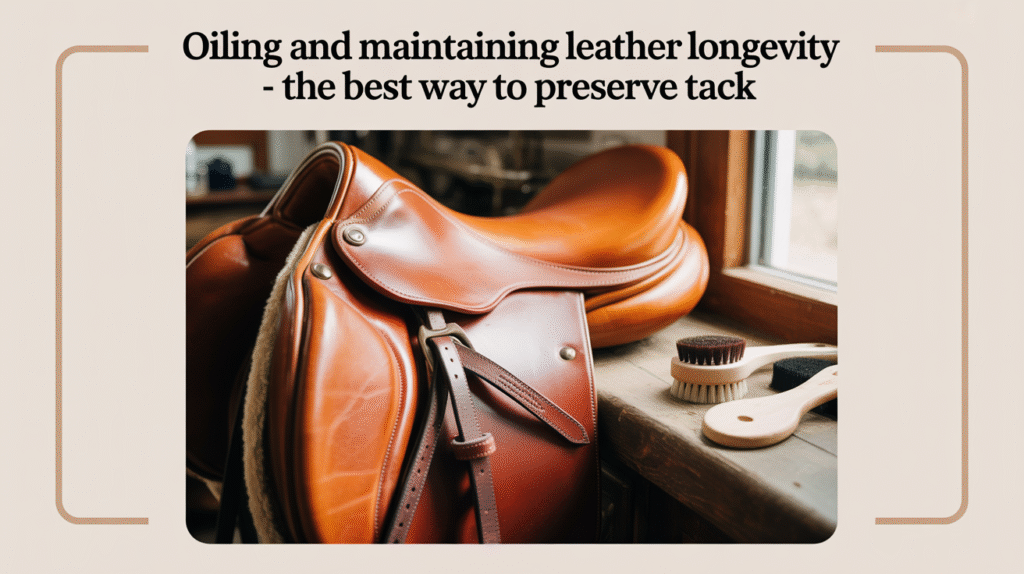The best way to maintain leather longevity is by regularly oiling it with leather-safe oils like neatsfoot or lanolin, followed by consistent conditioning and proper storage. Leather tack is a significant investment, and proper care ensures your saddles, bridles, and reins stay strong, supple, and safe for years to come. Over time, leather can dry, crack, or become brittle without the moisture and nourishment that oiling provides.

This guide will help you understand how to properly oil leather and keep your tack in excellent condition.
Why Oiling Leather Is Essential
Oiling leather isn’t just for aesthetic purposes, it’s a critical process that extends usability and prevents deterioration.
Restores Moisture and Flexibility
Leather is porous and loses moisture over time, especially with exposure to sun, sweat, or water.
- Oiling replenishes lost oils: Restores softness and pliability.
- Prevents cracking and stiffness: Especially important in older or sun-damaged tack.
Improves Durability and Resistance
Oiled leather holds up better in varying conditions.
- Improves water resistance: Makes tack more resilient to rain or sweat.
- Reduces wear and tear: Flexible leather is less likely to rip under stress.
Choosing the Right Oil for Leather Tack
Not all oils are created equal. The best oil depends on your tack’s condition and leather type.
Recommended Oils
These oils are known for their compatibility and effectiveness.
- Pure neatsfoot oil: A traditional and effective oil for deep conditioning.
- Lanolin-based oils: Great for softening and waterproofing.
- Mink oil: Adds moisture and a protective barrier but can darken leather.
Oils to Avoid
Some oils can clog pores or damage the leather’s surface.
- Olive oil or vegetable oils: Can go rancid and degrade leather over time.
- Mineral oils or petroleum-based products: May weaken fibers or leave residue.
Step-by-Step: How to Oil Leather Tack Properly
Follow these steps for safe and effective oiling of saddles, bridles, and other gear.
Clean the Leather First
Before oiling, remove all dust, sweat, and residues.
- Use a damp cloth with leather cleaner: Avoid harsh detergents.
- Allow it to fully dry: Oil applied to wet leather can cause mold.
Apply Oil Evenly
Less is more when oiling tack. Apply a thin, even layer.
- Use a soft cloth or sponge: Dip and wipe lightly over all surfaces.
- Pay attention to stress points: Girth straps, reins, and billets need extra care.
Let the Oil Soak In
Let the leather absorb the oil fully before riding or storing.
- Allow several hours or overnight: For deeper penetration.
- Wipe off any excess: Prevents sticky buildup.
Repeat If Necessary
Extremely dry tack may need multiple light applications.
- Apply in layers, not all at once: This ensures absorption without over-saturation.
- Check flexibility after each round: Stop when the leather becomes supple.
Maintenance Tips to Keep Leather Strong
Oiling is one part of a full maintenance routine that protects and prolongs leather tack.
Condition Between Oilings
Conditioners nourish the surface and maintain softness.
- Use beeswax or lanolin-based conditioners: Prevents drying and keeps the leather resilient.
- Apply after rides or monthly: Depending on use and climate.
Store Tack Properly
Environmental conditions impact leather longevity as much as oiling.
- Keep in a cool, dry place: Avoid moisture and direct sunlight.
- Use breathable covers: Never store in plastic which traps humidity.
Avoid Over-Oiling
Too much oil can make leather limp or sticky.
- Oiling once every 3–6 months: Is usually sufficient for most tack.
- Only oil dry or stiff areas: Leave already supple leather untouched.
FAQs
Here are some questions and answers about oiling and maintaining leather longevity:
How often should I oil my tack?
Generally, every 3–6 months depending on climate and frequency of use. Tack used in hot, dry, or wet conditions may need more frequent oiling.
What’s the difference between oiling and conditioning?
Oiling penetrates and restores internal moisture, while conditioning softens the surface and provides a light protective coating. Both are important in a full maintenance routine.
Can I ride immediately after oiling leather?
It’s best to wait until the oil fully soaks in. Riding on freshly oiled tack may transfer oil to your clothing and attract dirt.
Should I oil new leather tack?
Yes, but lightly. New leather often benefits from initial oiling to soften it, but avoid over-saturating as new leather may already be treated.
What are signs that my tack needs oiling?
If the leather feels dry, stiff, or begins to show light cracks when bent, it’s time to oil. Also, tack that squeaks or feels brittle should be inspected and conditioned.
Oiling and maintaining your leather tack is a small effort with big rewards. By choosing the right products and following a regular care schedule, you’ll ensure your saddles and bridles remain strong, safe, and comfortable — ride after ride.